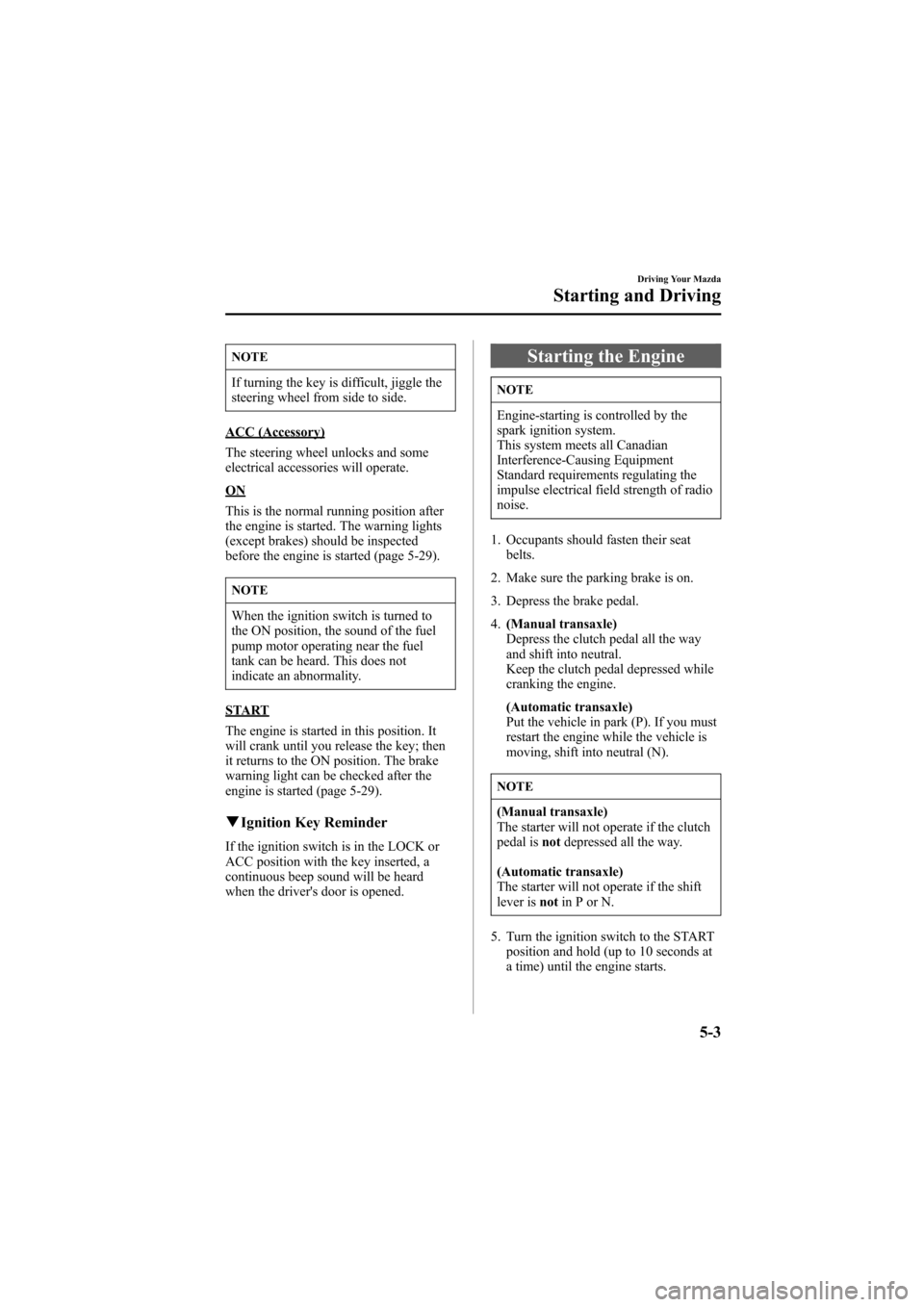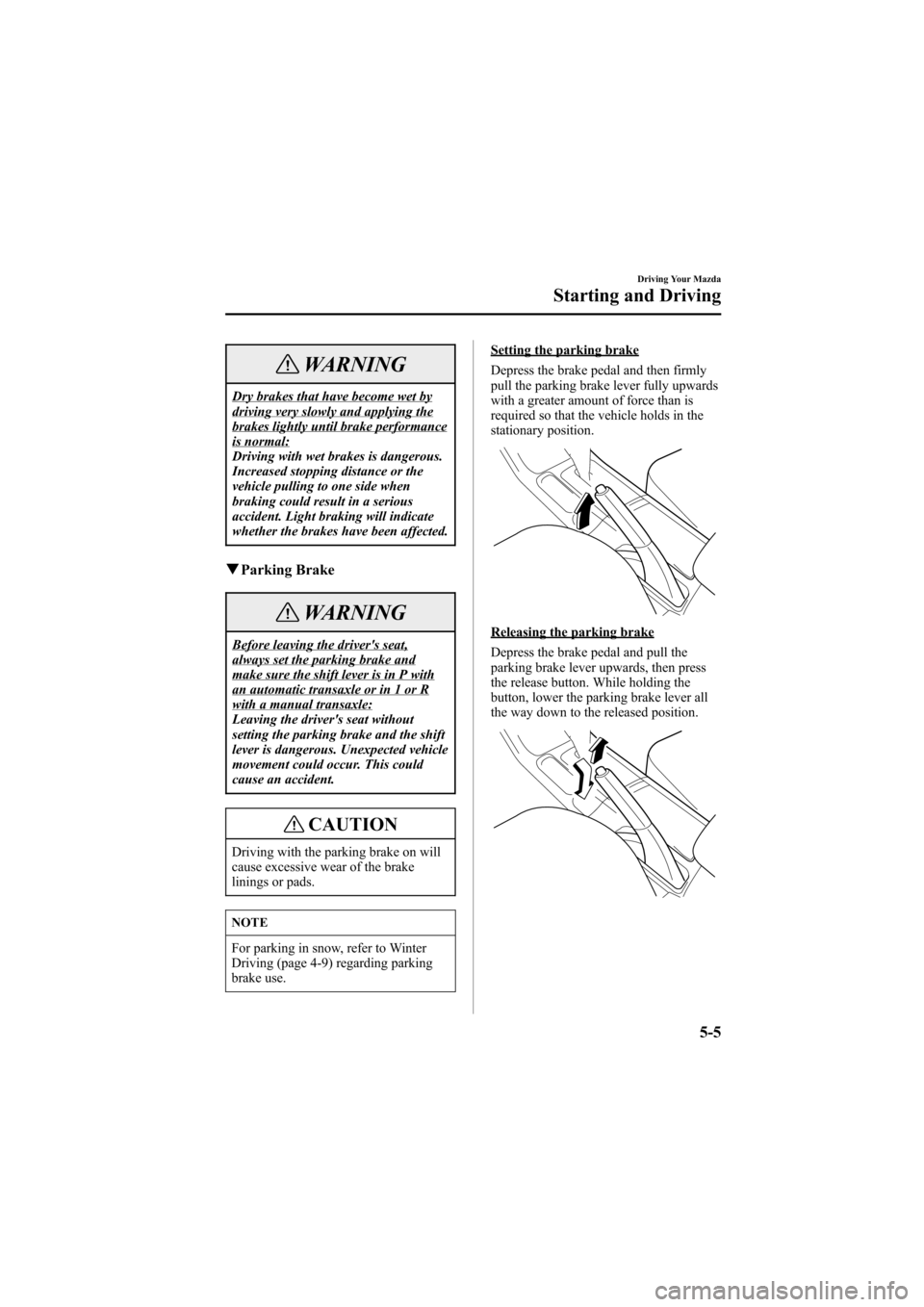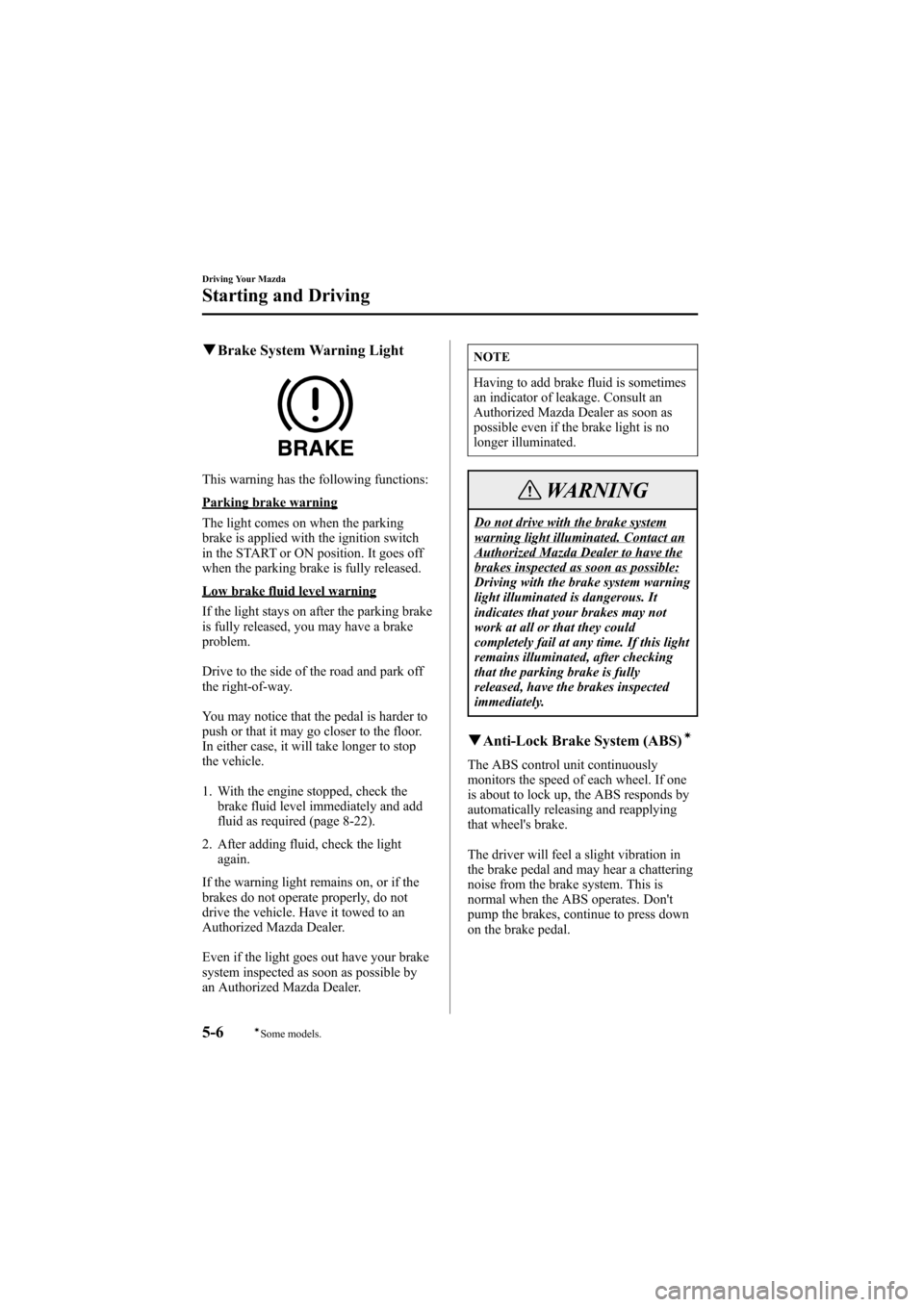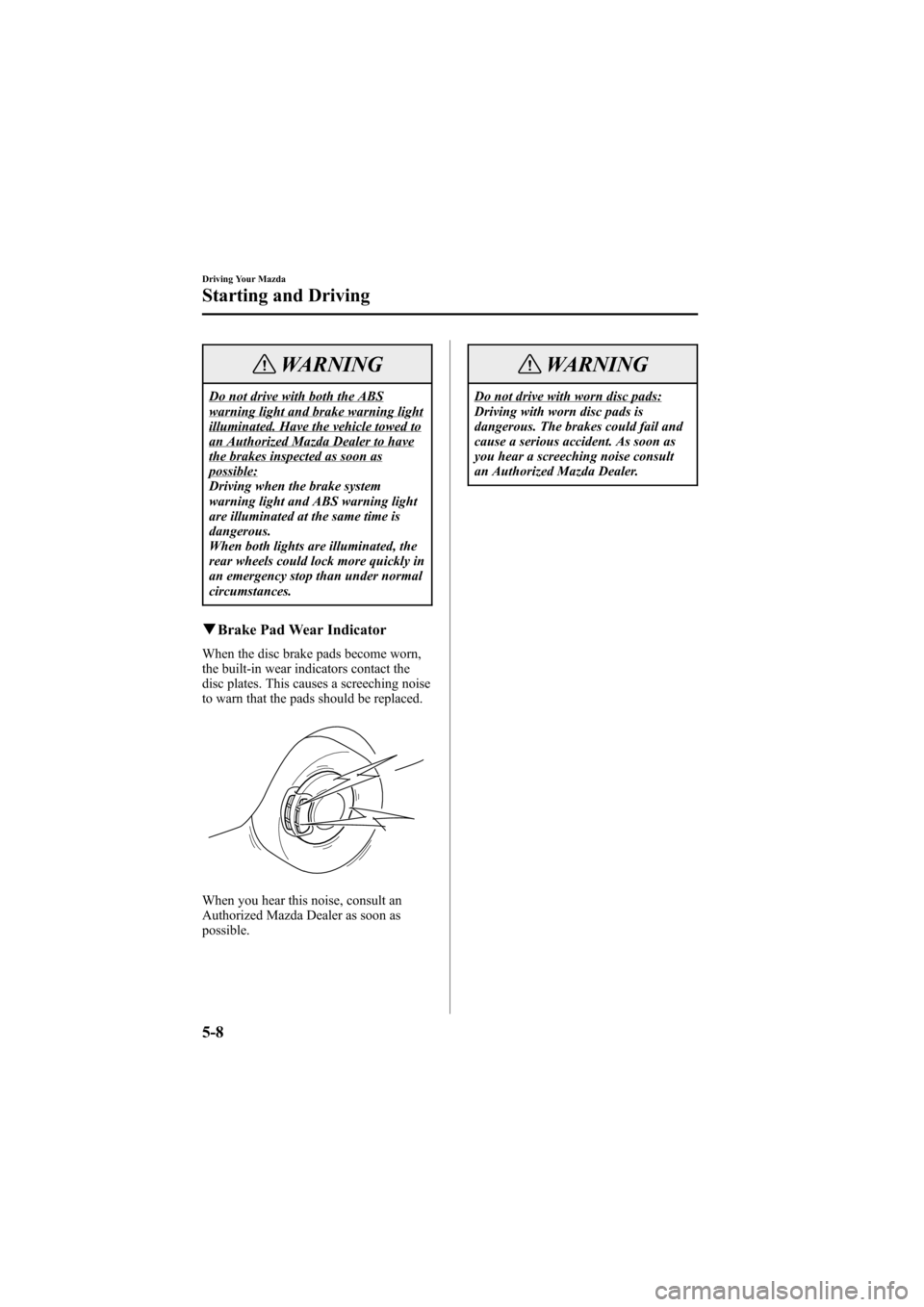warning MAZDA MODEL 6 2007 (in English) Manual Online
[x] Cancel search | Manufacturer: MAZDA, Model Year: 2007, Model line: MODEL 6, Model: MAZDA MODEL 6 2007Pages: 384, PDF Size: 4.22 MB
Page 134 of 384

Black plate (134,1)
Ignition Switch
qIgnition Switch Positions
LOCK
The steering wheel locks to protect
against theft. Only in this position can the
key be removed.
Manual transaxle
To turn the key from the ACC to the
LOCK position, push the key in at the
ACC position, then turn it to the LOCK
position.
Push the key
Automatic transaxle
To turn the key from the ACC to the
LOCK position, the shift lever must be in
the P position.
Shift lever
engaged in P
(park)
WARNING
Remove the key only when the vehicleis parked:
Removing the key from the ignition
switch while the vehicle is moving is
dangerous. Removing the key allows
the steering wheel to lock. You will
lose steering control and a serious
accident could occur.
Before leaving the driver's seat,always set the parking brake andmake sure the shift lever is in P withan automatic transaxle or in 1 or Rwith a manual transaxle:
Leaving the driver's seat without
setting the parking brake and the shift
lever is dangerous. Unexpected vehicle
movement could occur. This could
cause an accident.
5-2
Driving Your Mazda
Starting and Driving
Mazda6_8W89-EA-06K_Edition1 Page134
Tuesday, November 14 2006 1:23 PM
Form No.8W89-EA-06K
Page 135 of 384

Black plate (135,1)
NOTE
If turning the key is difficult, jiggle the
steering wheel from side to side.
ACC (Accessory)
The steering wheel unlocks and some
electrical accessories will operate.
ON
This is the normal running position after
the engine is started. The warning lights
(except brakes) should be inspected
before the engine is started (page 5-29).
NOTE
When the ignition switch is turned to
the ON position, the sound of the fuel
pump motor operating near the fuel
tank can be heard. This does not
indicate an abnormality.
START
The engine is started in this position. It
will crank until you release the key; then
it returns to the ON position. The brake
warning light can be checked after the
engine is started (page 5-29).
qIgnition Key Reminder
If the ignition switch is in the LOCK or
ACC position with the key inserted, a
continuous beep sound will be heard
when the driver's door is opened.
Starting the Engine
NOTE
Engine-starting is controlled by the
spark ignition system.
This system meets all Canadian
Interference-Causing Equipment
Standard requirements regulating the
impulse electrical field strength of radio
noise.
1. Occupants should fasten their seat
belts.
2. Make sure the parking brake is on.
3. Depress the brake pedal.
4.(Manual transaxle)
Depress the clutch pedal all the way
and shift into neutral.
Keep the clutch pedal depressed while
cranking the engine.
(Automatic transaxle)
Put the vehicle in park (P). If you must
restart the engine while the vehicle is
moving, shift into neutral (N).
NOTE
(Manual transaxle)
The starter will not operate if the clutch
pedal isnotdepressed all the way.
(Automatic transaxle)
The starter will not operate if the shift
lever isnotin P or N.
5. Turn the ignition switch to the START
position and hold (up to 10 seconds at
a time) until the engine starts.
Driving Your Mazda
Starting and Driving
5-3
Mazda6_8W89-EA-06K_Edition1 Page135
Tuesday, November 14 2006 1:23 PM
Form No.8W89-EA-06K
Page 136 of 384

Black plate (136,1)
CAUTION
Don't try the starter for more than 10
seconds at a time. If the engine stalls or
fails to start, wait 10 seconds before
trying again. Otherwise, you may
damage the starter and drain the battery.
6. After starting the engine, let it idle for
about 10 seconds.
NOTE
lIn extremely cold weather, below
_
18 °C (0 °F), or after the vehicle
has not been driven in several days,
let the engine warm up without
operating the accelerator.
lWhether the engine is cold or warm,
it should be started without use of
the accelerator.
Brake System
qFoot Brake
Your Mazda has power-assisted brakes
that adjust automatically through normal
use.
Should power-assist fail, you can stop by
applying greater force than normal to the
brake pedal. But the distance required to
stop will be greater than usual.
WARNING
Do not coast with the engine stalled orturned off, find a safe place to stop:
Coasting with the engine stalled or
turned off is dangerous. Braking will
require more effort, and the brake's
power-assist could be depleted if you
pump the brake. This will cause
longer stopping distances or even an
accident.
Shift to a lower gear when going downsteep hills:
Driving with your foot continuously
on the brake pedal or steadily applying
the brakes for long distances is
dangerous. This causes overheated
brakes, resulting in longer stopping
distances or even total brake failure.
This could cause loss of vehicle
control and a serious accident. Avoid
continuous application of the brakes.
5-4
Driving Your Mazda
Starting and Driving
Mazda6_8W89-EA-06K_Edition1 Page136
Tuesday, November 14 2006 1:23 PM
Form No.8W89-EA-06K
Page 137 of 384

Black plate (137,1)
WARNING
Dry brakes that have become wet bydriving very slowly and applying thebrakes lightly until brake performanceis normal:
Driving with wet brakes is dangerous.
Increased stopping distance or the
vehicle pulling to one side when
braking could result in a serious
accident. Light braking will indicate
whether the brakes have been affected.
qParking Brake
WARNING
Before leaving the driver's seat,always set the parking brake andmake sure the shift lever is in P withan automatic transaxle or in 1 or Rwith a manual transaxle:
Leaving the driver's seat without
setting the parking brake and the shift
lever is dangerous. Unexpected vehicle
movement could occur. This could
cause an accident.
CAUTION
Driving with the parking brake on will
cause excessive wear of the brake
linings or pads.
NOTE
For parking in snow, refer to Winter
Driving (page 4-9) regarding parking
brake use.
Setting the parking brake
Depress the brake pedal and then firmly
pull the parking brake lever fully upwards
with a greater amount of force than is
required so that the vehicle holds in the
stationary position.
Releasing the parking brake
Depress the brake pedal and pull the
parking brake lever upwards, then press
the release button. While holding the
button, lower the parking brake lever all
the way down to the released position.
Driving Your Mazda
Starting and Driving
5-5
Mazda6_8W89-EA-06K_Edition1 Page137
Tuesday, November 14 2006 1:23 PM
Form No.8W89-EA-06K
Page 138 of 384

Black plate (138,1)
qBrake System Warning Light
This warning has the following functions:
Parking brake warning
The light comes on when the parking
brake is applied with the ignition switch
in the START or ON position. It goes off
when the parking brake is fully released.
Low brake fluid level warning
If the light stays on after the parking brake
is fully released, you may have a brake
problem.
Drive to the side of the road and park off
the right-of-way.
You may notice that the pedal is harder to
push or that it may go closer to the floor.
In either case, it will take longer to stop
the vehicle.
1. With the engine stopped, check the
brake fluid level immediately and add
fluid as required (page 8-22).
2. After adding fluid, check the light
again.
If the warning light remains on, or if the
brakes do not operate properly, do not
drive the vehicle. Have it towed to an
Authorized Mazda Dealer.
Even if the light goes out have your brake
system inspected as soon as possible by
an Authorized Mazda Dealer.
NOTE
Having to add brake fluid is sometimes
an indicator of leakage. Consult an
Authorized Mazda Dealer as soon as
possible even if the brake light is no
longer illuminated.
WARNING
Do not drive with the brake systemwarning light illuminated. Contact anAuthorized Mazda Dealer to have thebrakes inspected as soon as possible:
Driving with the brake system warning
light illuminated is dangerous. It
indicates that your brakes may not
work at all or that they could
completely fail at any time. If this light
remains illuminated, after checking
that the parking brake is fully
released, have the brakes inspected
immediately.
qAnti-Lock Brake System (ABS)í
The ABS control unit continuously
monitors the speed of each wheel. If one
is about to lock up, the ABS responds by
automatically releasing and reapplying
that wheel's brake.
The driver will feel a slight vibration in
the brake pedal and may hear a chattering
noise from the brake system. This is
normal when the ABS operates. Don't
pump the brakes, continue to press down
on the brake pedal.
5-6
Driving Your Mazda
íSome models.
Starting and Driving
Mazda6_8W89-EA-06K_Edition1 Page138
Tuesday, November 14 2006 1:23 PM
Form No.8W89-EA-06K
Page 139 of 384

Black plate (139,1)
WARNING
Do not rely on ABS as a substitute forsafe driving:
The ABS cannot compensate for
unsafe and reckless driving, excessive
speed, tailgating (following another
vehicle too closely), driving on ice and
snow, and hydroplaning (reduced tire
friction and road contact because of
water on the road surface). You can
still have an accident.
NOTE
Braking distances may be longer on
loose surfaces (snow or gravel, for
example) which usually have a hard
foundation. A vehicle with a normal
braking system may require less
distance to stop under these conditions
because the tires will build up a wedge
of surface layer when the wheels skid.
qABS Warning Lightí
The warning light stays on for a few
seconds when the ignition switch is turned
to the ON position.If the ABS warning light stays on while
you're driving, the ABS control unit has
detected a system malfunction. If this
occurs, your brakes will function normally
as if the vehicle had no ABS.
Should this happen, consult an Authorized
Mazda Dealer as soon as possible.
NOTE
When the engine is jump-started to
charge the battery, uneven rpm occurs
and the ABS warning light comes on.
This is due to a weak battery, not a
malfunction.
Recharge the battery.
qElectronic Brake Force
Distribution System Warningí
If the electronic brake force distribution
control unit determines that some
components are operating incorrectly, the
control unit may turn the brake system
warning light and the ABS warning light
on at the same time. The problem is likely
to be an electronic brake force distribution
system.
Driving Your Mazda
Starting and Driving
5-7íSome models. Mazda6_8W89-EA-06K_Edition1 Page139
Tuesday, November 14 2006 1:23 PM
Form No.8W89-EA-06K
Page 140 of 384

Black plate (140,1)
WARNING
Do not drive with both the ABSwarning light and brake warning lightilluminated. Have the vehicle towed toan Authorized Mazda Dealer to havethe brakes inspected as soon aspossible:
Driving when the brake system
warning light and ABS warning light
are illuminated at the same time is
dangerous.
When both lights are illuminated, the
rear wheels could lock more quickly in
an emergency stop than under normal
circumstances.
qBrake Pad Wear Indicator
When the disc brake pads become worn,
the built-in wear indicators contact the
disc plates. This causes a screeching noise
to warn that the pads should be replaced.
When you hear this noise, consult an
Authorized Mazda Dealer as soon as
possible.
WARNING
Do not drive with worn disc pads:
Driving with worn disc pads is
dangerous. The brakes could fail and
cause a serious accident. As soon as
you hear a screeching noise consult
an Authorized Mazda Dealer.
5-8
Driving Your Mazda
Starting and Driving
Mazda6_8W89-EA-06K_Edition1 Page140
Tuesday, November 14 2006 1:23 PM
Form No.8W89-EA-06K
Page 141 of 384

Black plate (141,1)
Manual Transaxle Operation
qManual Transaxle Shift Pattern
Neutral position
The shift pattern of the transaxle is
conventional, as shown.
Depress the clutch pedal all the way down
while shifting; then release it slowly.
A safety feature prevents accidental
shifting from 5 to R (reverse). The shift
lever must be put in neutral before being
shifted to R.
WARNING
Do not use sudden engine braking onslippery road surfaces or at highspeeds:
Shifting down while driving on wet,
snowy, or frozen roads, or while
driving at high speeds causes sudden
engine braking, which is dangerous.
The sudden change in tire speed could
cause the tires to skid. This could lead
to loss of vehicle control and an
accident.
Be sure to leave the shift lever in 1 orR position and set the parking brakewhen leaving the vehicle unattended:
Otherwise the vehicle could move and
cause an accident.
CAUTION
lKeep your foot off the clutch pedal
except when shifting gears. Also,
don't use the clutch to hold the
vehicle on an upgrade. Riding the
clutch will cause needless clutch
wear and damage.
lMake sure the vehicle comes to a
complete stop before shifting to R.
Shifting to R while the vehicle is still
moving may damage the transaxle.
NOTE
If shifting to R is difficult, shift back
into neutral, release the clutch pedal,
and try again.
Driving Your Mazda
Starting and Driving
5-9
Mazda6_8W89-EA-06K_Edition1 Page141
Tuesday, November 14 2006 1:23 PM
Form No.8W89-EA-06K
Page 143 of 384

Black plate (143,1)
Automatic Transaxle Controls
Indicates that you must depress the brake pedal to shift (The ignition
switch must be in the ACC or ON position).
Indicates the shift lever can be shifted freely into any position.
Various Lockouts:
qTransaxle Ranges
The shift lever must be in P or N to
operate the starter.
P (Park)
P locks the transaxle and prevents the
front wheels from rotating.
WARNING
Always set the shift lever to P AND setthe parking brake:
Only setting the shift lever to the P
position without using the parking
brake to hold the vehicle is dangerous.
If P fails to hold, the vehicle could
move and cause an accident.
CAUTION
lShifting into P, N or R while the
vehicle is moving can damage your
transaxle.
lShifting into a driving gear or
reverse when the engine is running
faster than idle can damage the
transaxle.
R (Reverse)
In position R, the vehicle moves only
backward. You must be at a complete stop
before shifting to or from R, except under
rare circumstances as explained in
Rocking the Vehicle (page 4-9).
Driving Your Mazda
Starting and Driving
5-11
Mazda6_8W89-EA-06K_Edition1 Page143
Tuesday, November 14 2006 1:23 PM
Form No.8W89-EA-06K
Page 144 of 384

Black plate (144,1)
N (Neutral)
In N, the wheels and transaxle are not
locked. The vehicle will roll freely even
on the slightest incline unless the parking
brake or brakes are on.
WARNING
If the engine is running faster thanidle, do not shift from N or P into adriving gear:
It's dangerous to shift from N or P
into a driving gear when the engine is
running faster than idle. If this is
done, the vehicle could move suddenly,
causing an accident or serious injury.
Do not shift into N when driving thevehicle:
Shifting into N while driving is
dangerous. Engine braking cannot be
applied when decelerating which
could lead to an accident or serious
injury.
CAUTION
Do not shift into N when driving the
vehicle. Doing so can cause transaxle
damage.
NOTE
Apply the parking brake or depress the
brake pedal before moving the shift
lever from N to prevent the vehicle
from moving unexpectedly.
D (Drive)
D is the normal driving position. From a
stop, the transaxle will automatically shift
through a 5-gear/6-gear
*sequence.
* 3.0-liter engine model
M (Manual)
M is the manual shift mode position.
Gears can be shifted up or down by
operating the shift lever.
Refer to Manual Shift Mode (page 5-13).
qShift-Lock System
The shift-lock system prevents shifting
out of P unless the brake pedal is
depressed.
To shift from P:
1. Depress and hold the brake pedal.
2. Start the engine.
3. Move the shift lever.
NOTE
lWhen the ignition switch is in the
LOCK position, the shift lever
cannot be shifted from P.
lTo be sure the vehicle is in park,the
ignition key cannot be removed
unless the shift lever is in P.
5-12
Driving Your Mazda
Starting and Driving
Mazda6_8W89-EA-06K_Edition1 Page144
Tuesday, November 14 2006 1:23 PM
Form No.8W89-EA-06K